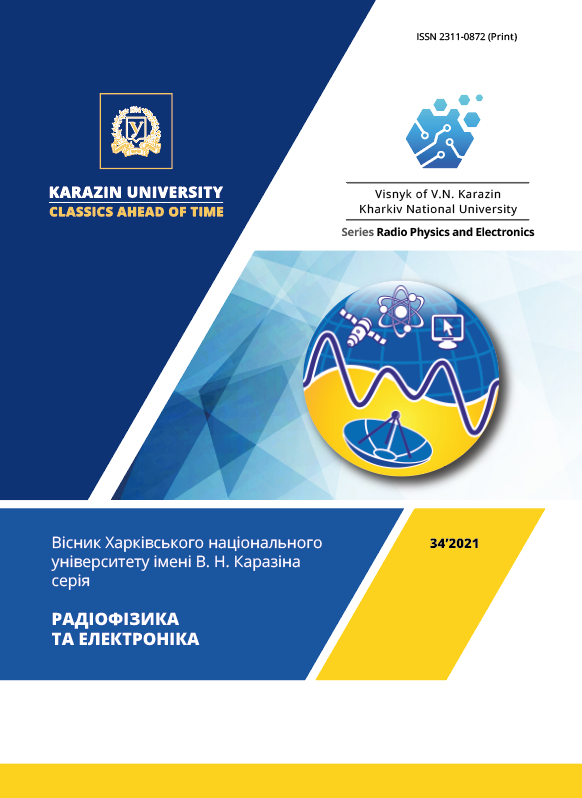Calculation method of the radar cross section of the complex shape object located on the surface with an arbitrary reflection coefficient
Abstract
Relevance. Currently, an important problem is the electromagnetic wave scattering modeling on the complex shape objects located on some underlying surface (this may be military equipment on bitumen/ grass, surface objects directly on the water). Such tasks are important when designing new inconspicuous equipment.
The purpose of the work. Consider the existing and suggest improvements in the method solving of the problem of electromagnetic wave diffraction on the complex shape object, which is located on some underlying surface. In this case, the change in the electromagnetic parameters of the underlying surface should not lead to the need to re-calculate the field scattered from the object.
Materials and methods. The diffraction problem is solved for the complex shape object, which is located on the underlying surface. The surface can be characterized by dielectric (and magnetic) permeability, complex reflection coefficient or surface impedance. In order to determine the resulting field for an object located on an arbitrary surface, the scattering problem is solved for cases when the object is located above an ideally conducting surface and above an ideal magnetic.
Results. A modeling technique for the scattering of the electromagnetic waves by the complex shape objects located above an underlying surface is proposed. Numerical experiments have been caried out in order to demonstrate the effectiveness of this technique.
Conclusion. It is shown that the method proposed in the article allows to effectively calculate the contribution of different underlying surfaces in the resulting scattered field of the complex shape objects that are located on it. You do not need to simulate directly for an object over a specific surface each time. It is enough to carry out only three simulations: for an object in free space, and also when ideal conductor and ideal magnetic are used as the underlying surface. Formulas that allow to calculate the field scattered by this object for an arbitrary underlying surface are obtained.
Downloads
References
2. Jiang, Wang-Qiang, et al. Rectangular Wave Beam Based GO/PO Method for RCS Simulation of Complex Target. Progress In Electromagnetics Research M. 2017;53:53-65. http://dx.doi.org/10.2528/PIERM16102401
3. Gao PC, et al. Parallel shooting and bouncing ray method with virtual divergence factor for fast analysis of scattering from complex targets. Progress in Electromagnetic Research Symposium (PIERS). IEEE, 2016. https://doi.org/10.1109/PIERS.2016.7735193
4. Breglia Alfonso, et al. Comparison of Acceleration Data Structures for Electromagnetic Ray-Tracing Purposes on GPUs [EM Programmer's Notebook]. IEEE Antennas and Propagation Magazine. 2015;57(5):159-176. https://doi.org/10.1109/MAP.2015.2470685
5. Charlotte Blair. HFSS Hybrid Finite Element and Integral Equation Solver and Savant for Large Scale Electromagnetic Design and Simulation. Technical presentation www.ieee.li/pdf/viewgraphs/hfss_hybrid_finite_element_and_integral_equation_solver.pdf
6. Johansen, Peter M. Time-domain version of the physical theory of diffraction. IEEE Transactions on Antennas and Propagation. 1999;47(2):261-270. https://doi.org/10.1109/8.761065
7. An, Y., et al. FPO-Based Shooting and Bouncing Ray Method for Wide-Band RCS Prediction. Applied Computational Electromagnetics Society Journal. 2014;29(4).
8. Ding Ji, et al. Analysis of transient electromagnetic scattering using the multilevel time domain fast dipole method. Progress In Electromagnetics Research. 2013; 140:401-413. https://doi.org/10.2528/PIER13041003
9. Frank Scharf. Automotive Radar at 77GHz; Coupled 3D-EM/Asymptotic Simulations. / CST STUDIO SUITE – North American Automotive Workshop 2016. www.cst.com/-/media/cst/landing-pages/2016automotive/automotive-radar-at-77ghz-coupled-3demasymptotic-simulations.ashx
10. Charlotte Blair. HFSS Hybrid Finite Element and Integral Equation Solver and Savant for Large Scale Electromagnetic Design and Simulation. Technical presentation www.ieee.li/pdf/viewgraphs/hfss_hybrid_finite_element_and_integral_equation_solver.pdf
11. Bankov SE, Kurushin AA. Calculation of radiated structures using FEKO M .: NPP RODNIK CJSC, 2008. 246 p. [In Russian]
12. Maisels EN Measurement of the scattering characteristics of radar targets. Ed. Kolosova MA, Maisels EN, Torgovanov VA. Moscow: Sov. radio, 1972. 232 P. [In Russian]
13. Kobak VO. Radar reflectors. Moscow: Soviet Radio, 1975. 348 p. [In Russian]
14. Kovalev SV, Nesterov SM, Skorodumov IA. Determination of RCS of objects taking into account re-reflections from the earth's surface. Radio engineering and electronics. 1996;41:1304–1310. [In Russian]
15. Khrychov V, Legenkiy M. Different components of the electromagnetic scattering of complex shape objects. Proceedings of the IEEE microwaves, radar and remote sensing symposium (MRRS-2020), 2020. https://doi.org/10.1109/UkrMW49653.2020.9252733




